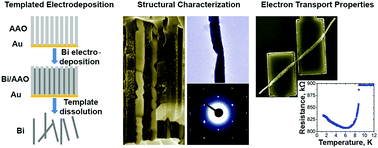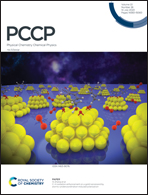Bismuth nanowires: electrochemical fabrication, structural features, and transport properties†
Abstract
Electrochemical aspects of Bi electrocrystallization from a bath containing bismuth nitrate in a mixture of ethylene glycol and water are addressed. Bismuth nanowires with diameters of 50–120 nm and a length of up to a few dozen microns were prepared by electrodeposition into the pores of anodic aluminium oxide templates. Crystal structure and morphology of electrodeposited materials were characterized using electron microscopy, selected area electron diffraction, and X-ray diffraction analysis. Factors affecting the formation of single or polycrystalline nanowires and their crystallographic orientation are discussed. The prospects of electrodeposited Bi nanostructures for microelectronics are illustrated by the quantitative resistivity measurements of highly texturized Bi nanowires with a diameter of ca. 100 nm and a length varying from 160 to 990 nm in a temperature range from 300 to 1.2 K.



 Please wait while we load your content...
Please wait while we load your content...